|
|
|
佐女川神社 1月14日
16:32
|
|
Samegawa Shrine on January
14 16:32
|
|
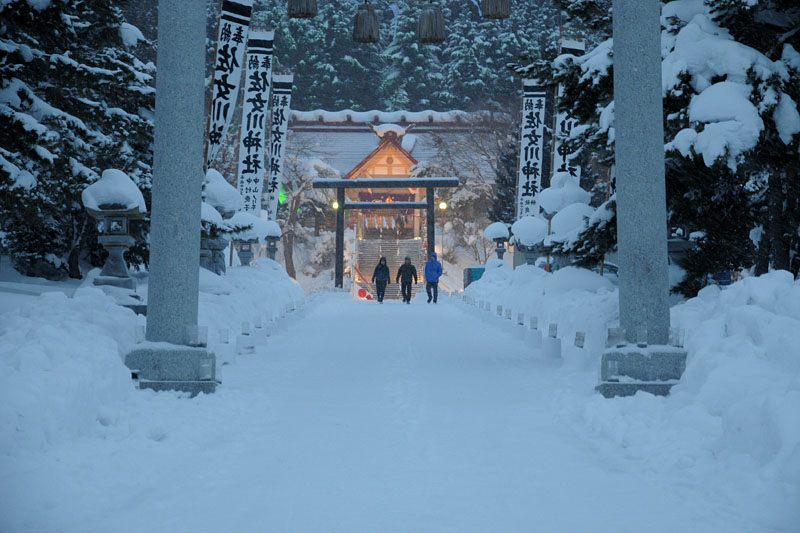
|
|
拡大写真(3000X2000)740KB |
|
|
|
|
|
|
かんみそぎ とじょうくわえし ぎょうじゃかな |
|
Midwinter Ablution, the ascetic biting a Tojo cloth. |
|
|
|
|
佐女川神社本殿前に整列する行修者 1月13日
18:40
|
|
Gyosyusya (ascetics) lined up in front of Samegawa Shrine on January
13 18:40
|
|
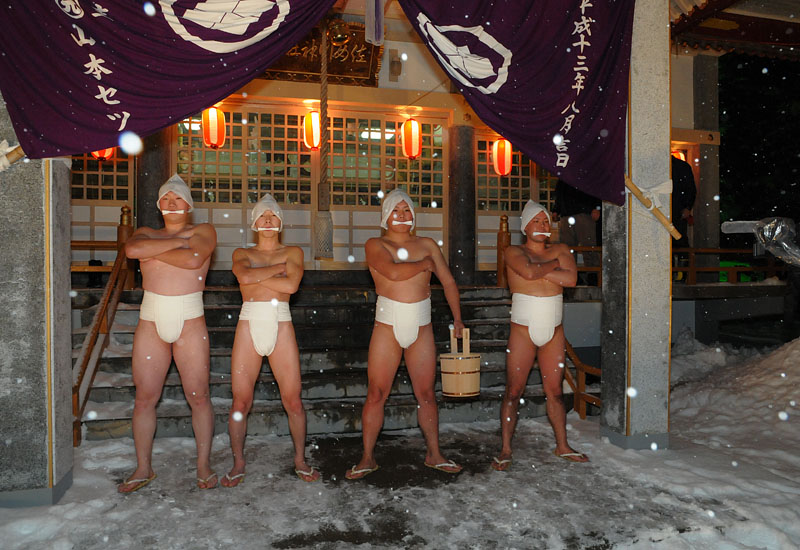
|
|
拡大写真(2400X1650)628KB |
|
|
|
|
日本と北海道
|
|
Japan and Hokkaido
|
|
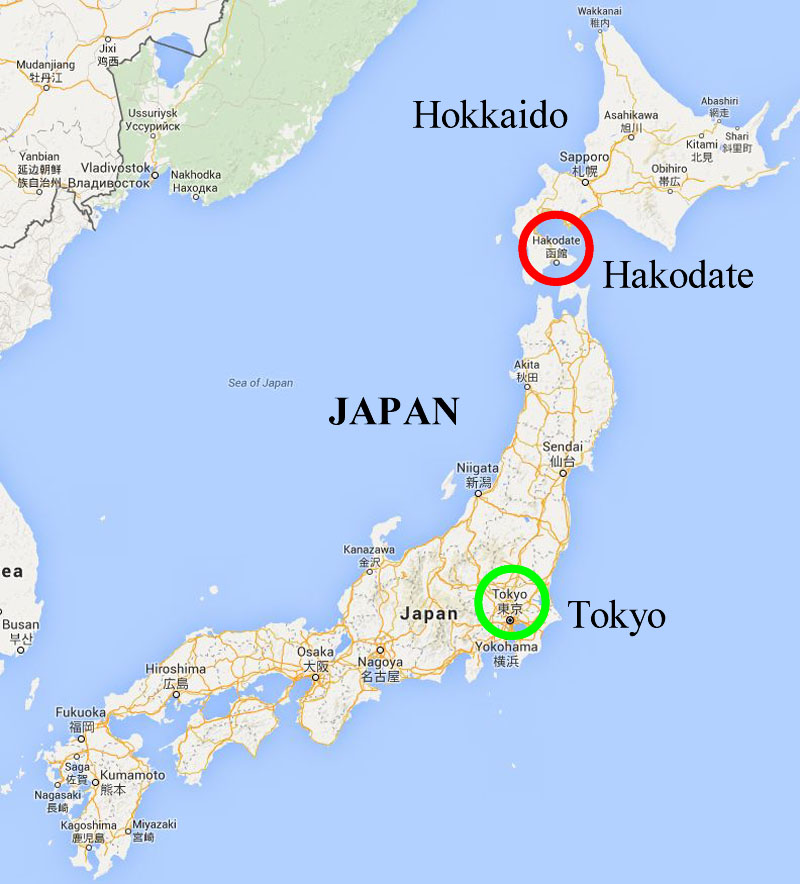
|
|
Google Map
|
|
|
|
|
|
|
|
木古内町 |
|
|
KIKONAI
TOWN
|
|
|
▼
木古内町は、渡島半島(おしまはんとう)南西部に位置し、函館市の西方約40kmにあり、津軽海峡に面した漁業、酪農、林業の町である。2016年現在、木古内町の人口は、約4,500人。 |
|
|
Kikonai Town is
locating about 40km away from City of Hakodate to the west on Oshima Peninsula. It faces Tsugaru Strait and the key industries are fishery, dairy farming and forestry. As of 2016, the number of population in Kikonai is about 4,500.
|
|
|
|
|
|
|
|
|
函館市と木古内町
|
|
City
of Hakodate and Kikonai Town
|
|
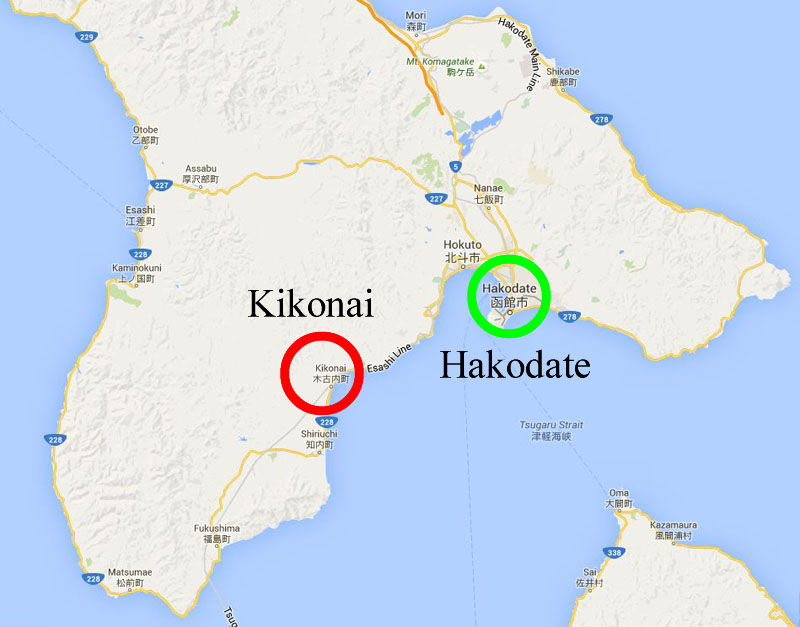
|
|
Google Map
|
|
|
|
|
|
|
|
北海道新幹線と木古内 |
|
|
THE
HOKKAIDO SHINKANSEN & KIKONAI
|
|
|
▼
東京と新函館北斗間を約4時間で走る北海道新幹線がいよいよ平成28年(2016)3月26日に開業する。木古内駅は、北海道新幹線が青函トンネルを抜けて最初に停車する北海道の新玄関口である。北海道新幹線は1日13往復するが、8往復16本が木古内駅に停車する。 |
|
|
The Hokkaido
Shinkansen which runs in approximately four hours between Tokyo and
Shin -Hakodate Hokuto finally starts business on March 26, 2016. Kikonai is the first stop in Hokkaido after going through the Seikan Tunnel (undersea
tunnel) so that Kikonai becomes
new gateway to Hokkaido. The Hokkaido Shinkansen makes 13 round trips every day.
And it stops 16 times at Kikonai Station in 8 round trips.
|
|
|
|
|
|
|
|
|
北海道新幹線
|
|
The
Hokkaido shinkansen
|
|
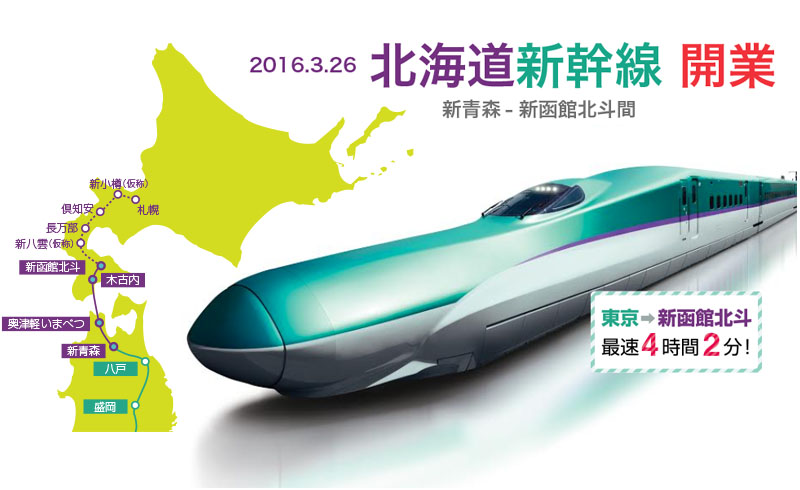
|
|
資料:JR北海道
|
|
|
|
|
北海道新幹線のルートマップ
|
|
Root
map of the Hokkaido shinkansen
|
|
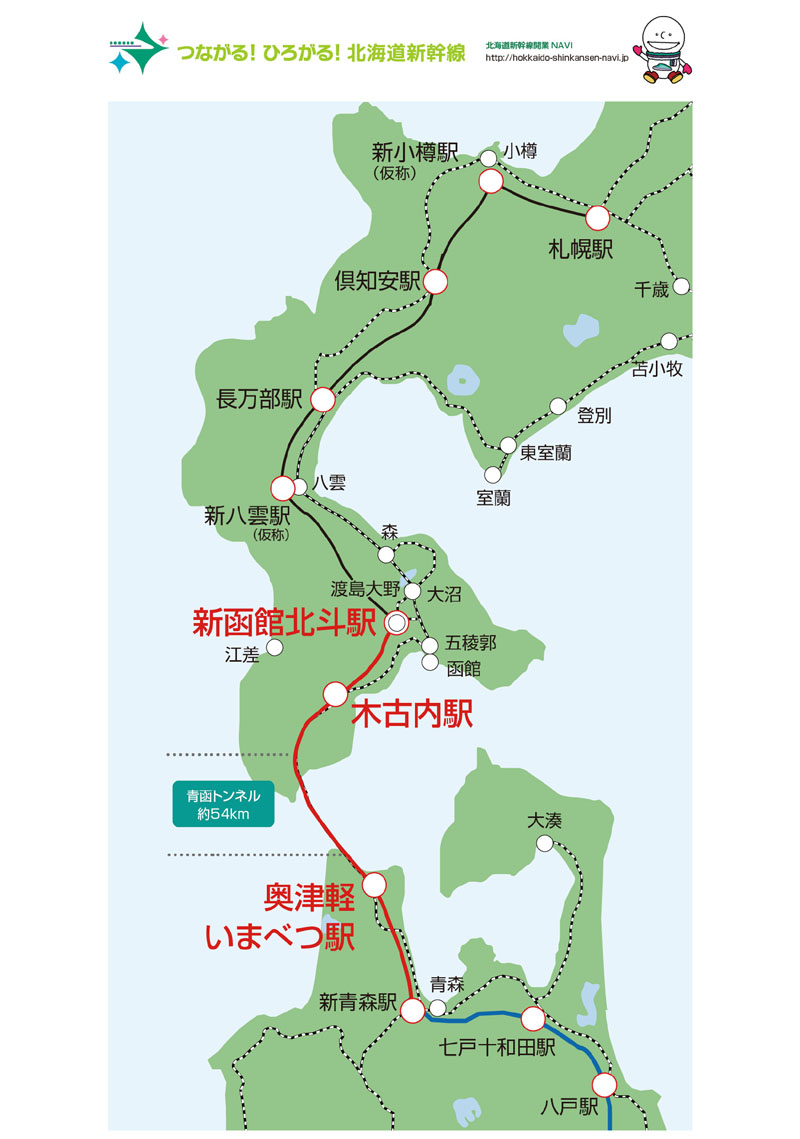
|
|
資料:JR北海道
|
|
|
|
|
|
|
|
新幹線車内誌「トランヴェール」に写真掲載! |
|
|
SHINKANSEN'S
'TRAIN VERT' POSTED OUR PHOTOS!
|
|
|
▼
平成28年(2016)3月26日に予定されている北海道新幹線の開業を前に、JR東日本が発行する新幹線車内誌「トランヴェール」2015年12月号に極寒の神事「寒中みそぎ祭り」が特集され、光栄にもWa☆Daフォトギャラリーの「木古内寒中みそぎ祭」 http://wadaphoto.jp/maturi/kiko03.htm
から写真3枚が掲載された(43頁)。
写真提供:Wa☆Daフォトギャラリー 撮影:上平明 |
|
Prier to the opening of Hokkaido Shinkansen from March
26, 2016, Shinkansen's 'Train Vert'
posted 3 photos from 'Midwinter
Ablution Festival' http://wadaphoto.jp/maturi/kiko03.htm
of Wada Photo Gallery in the feature articles of Hokkaodo on page 43. 'Train Vert' is the free magazine placed on the
back of the seats of Shinkansen published by JR East Japan.
We feel very honorable.
Photos presented by Wada Photo Gallery, taken by Akira Kamihira
|
|
|
|
|
|
|
|
|
|
|
|
|
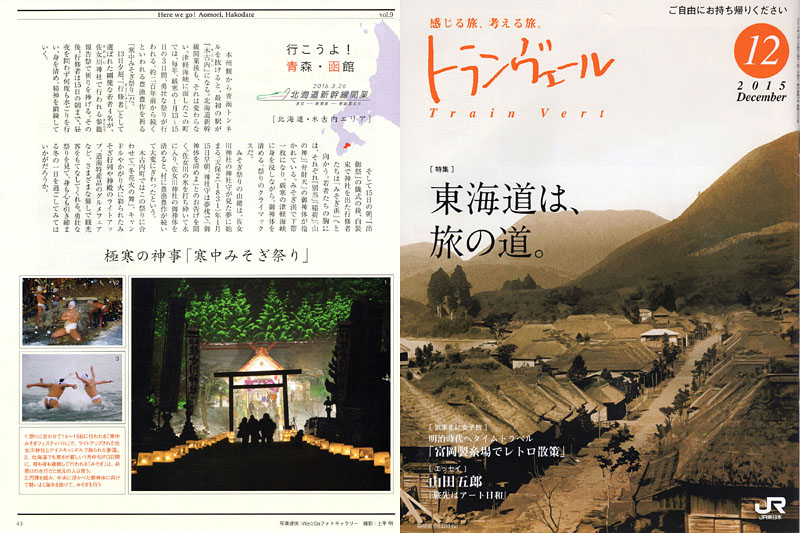
|
|
拡大写真(3000X2000)989KB |
|
|
|
|
|
|
|
▼
木古内の地名は、アイヌ語の「リコナイ(高く昇る源)」、または「リロナイ(潮の差し入る川)」から転訛したものといわれ、北海道ではその歴史は古く、570年ほど前から和人が定住したといわれている。 |
|
The origin of the name of Kikonai came from the language of Ainu (indigenous people in Hokkaido). It is said that
Kikonai comes from the word Rikonai the birthplace of rising-up water, or Rironai the river coming up the tidal current.
Wajin (Japanese whose origin is mainland of Japan) settled down here about 570 years ago. This is one of the earliest historic facts in Hokkaido.
|
|
|
|
|
|
|
|
|
佐女川神社とみそぎ浜/木古内町
|
|
Samegawa
Shrine and Misogi Beach at Kikonai Town
|
|
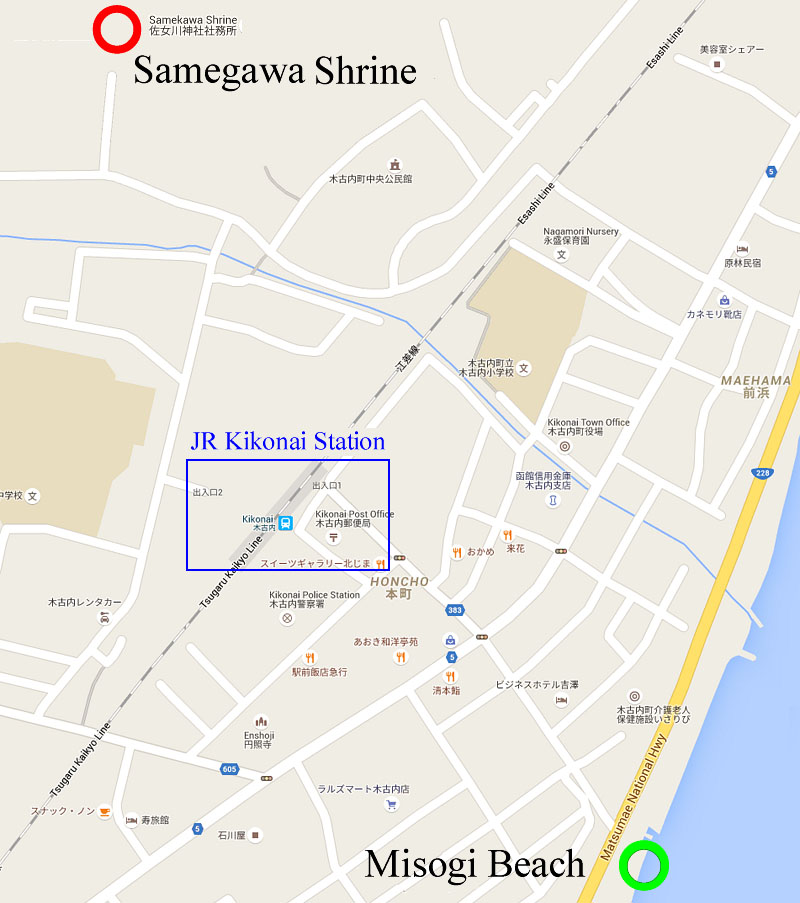
|
|
Google Map
|
|
|
2016年寒中みそぎ祭りのMAP
|
|
Map of Midwinter Ablution Festival in 2016
|
|
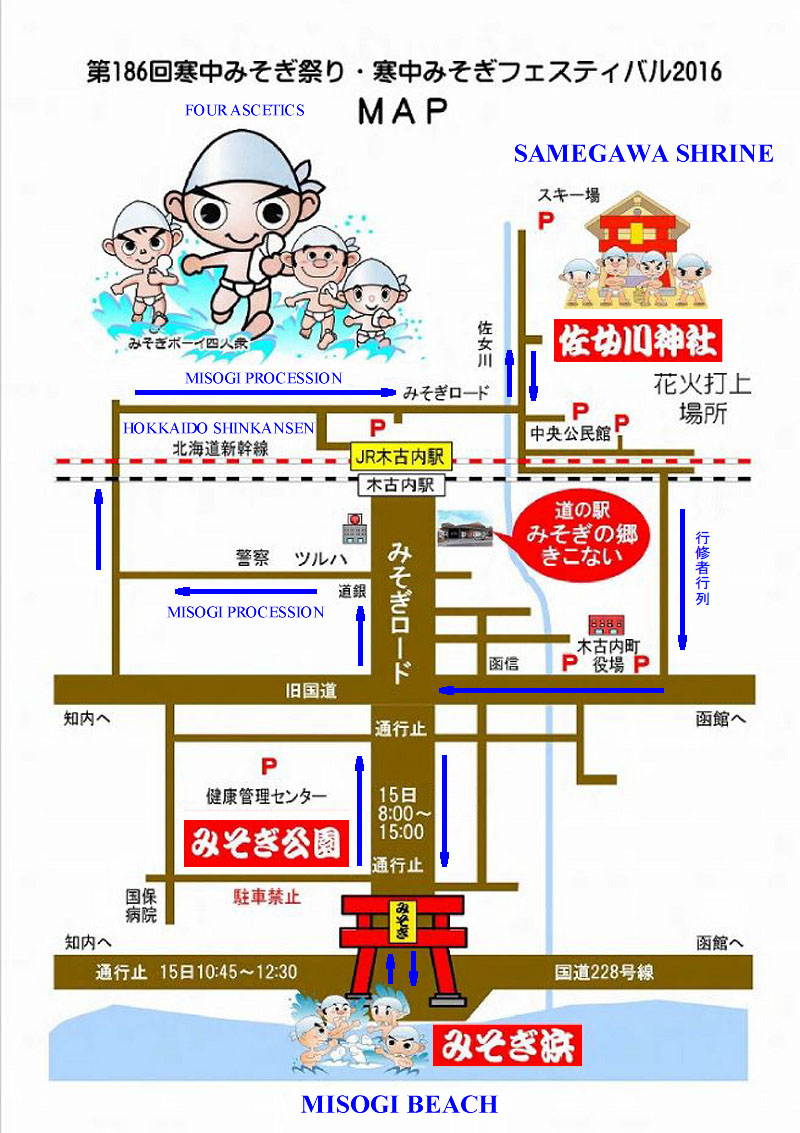
|
|
|
|
|
|
|
|
佐女川神社 |
|
|
SAMEGAWA
SHRINE
|
|
|
▼
佐女川神社は、寛永2年(1625)、松前藩地頭の河野加賀守源景広が武運長久を祈願して、佐女川のほとりに祠(ほこら)を建てたのが始まりといわれている。
海辺の町にふさわしく、主祭神は、海神・綿津見の大神の娘で、日本初代の天皇・神武天皇の母上にあたる玉依姫命(たまよりひめのみこと)である。 |
|
The original Samegawa Shrine was built near Samegawa River in Kikonai by the lord of a manor in Matsumae
Domain in 1625. They say that the shrine was built to pray for long-lasting good luck in battle.
Appropriately for the seaside town, Main enshrined deity is Tamayorihime-no-Mikoto who is the daughter of Watatsumi-no-Ookami the Shinto deity of the Sea, and also the mother of
Jinmu-Tennoh the first Emperor of Japan.
|
|
|
|
|
|
|
|
アイスキャンドル(氷灯籠)が誘う佐女川神社 1月14日
|
|
Samegawa Shrine to which the ice candles inviting
January 14
|
|
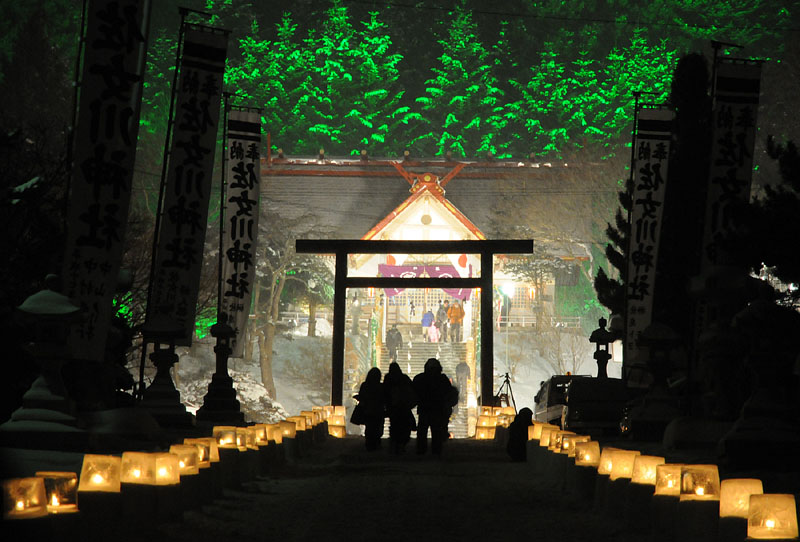
|
|
拡大写真(1800X1220)301KB |
|
|
|
|
|
|
|
|
| KANNON
BOSATSU BY ENKU
THE BUDDHIST
MONK |
|
▼
寛文6年(1666)のころ、僧円空(1632-1695)が来道し、鉈堀(なたぼり)像(観音座像)一体を安置した社が観音堂と称され、長く村人の信仰を集めていた。
明治維新によって新政府が発足すると、慶応4年(1868)3月に廃仏毀釈令(はいぶつきしゃくれい)が出され、観音堂や観音座像が打ち壊されそうになったため、信心深い村人たちが観音座像を神道の主神として村内数社を合祀し、名称を佐女川神社と改めて木古内村の鎮守とした。
|
|
|
|
Enku (1632-1695) who was a Japanese Buddhist monk came to Kikonai during the early Edo period (1603-1868). He was a famous for carving some 120,000 wooden statues of the Buddha across the country. He carved a seated statue of Kannon (deity of Mercy) and enshrined in a smal temple. Local residents in Kikonai called it Kannon-do (a hall devoted to Kannon) and practiced their religion there for a long period. |
|
Entering the Meiji period (from 1868), anti-Buddhism movement began and the destruction of Buddhist property took place on a large scale all over the country. |
|
The kannon-do was going to be destroyed but religious people guarded both it and the seated statue of Kannon. After that the people renamed it Samegawa shrine and made the seated statue of Kannon its main enshrined
deity. Then Samegawa shrine became the village shrine in
Kikonai. |
|
|
|
|
|
|
|
|
|
石段下の神社境内に設けられたみそぎ斎場 1月15日 09:48
|
|
Misogi Saijo
where ablution take place January 15 09:48
|
|
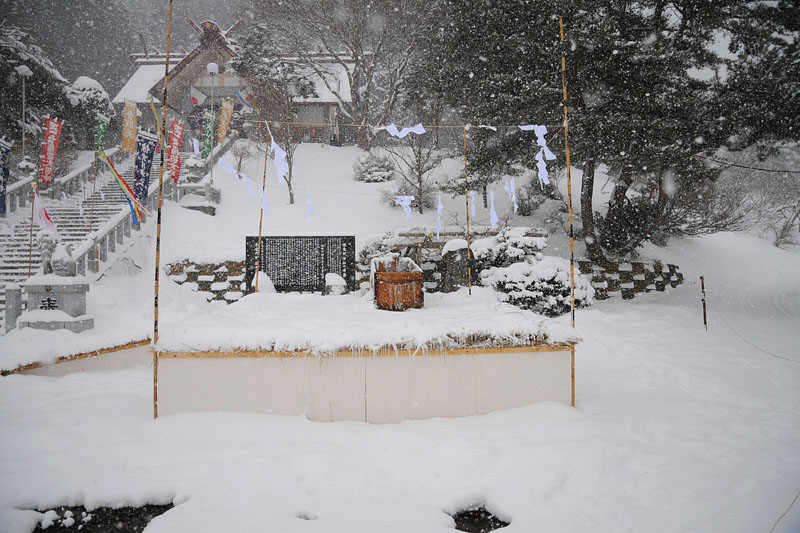
|
|
拡大写真(3000x2000)1.09MB |
|
|
|
|
|
|
|
▲▼ 石段下の神社境内に設けられたみそぎ斎場は、四隅に笹竹が立てられ、注連縄が張り巡らされており、結界の中は、みそぎを行う神聖な斎場となっている。 |
|
|
Misogi Saijo where ascetics' ablution take place is set up at the bottom of the stone steps. Bamboo poles are planted in the four corners of Misogi Saijo. Sacred rice-straw ropes are stretched there to show a holy area.
|
|
|
|
|
|
|
|
雪中禊ぎをする行修者・別当
/ アニメーション 1月13日18:57
|
|
Purifying Gyosyusya (ascetics)
Betto in snow / animation January 13 18:57
|
|
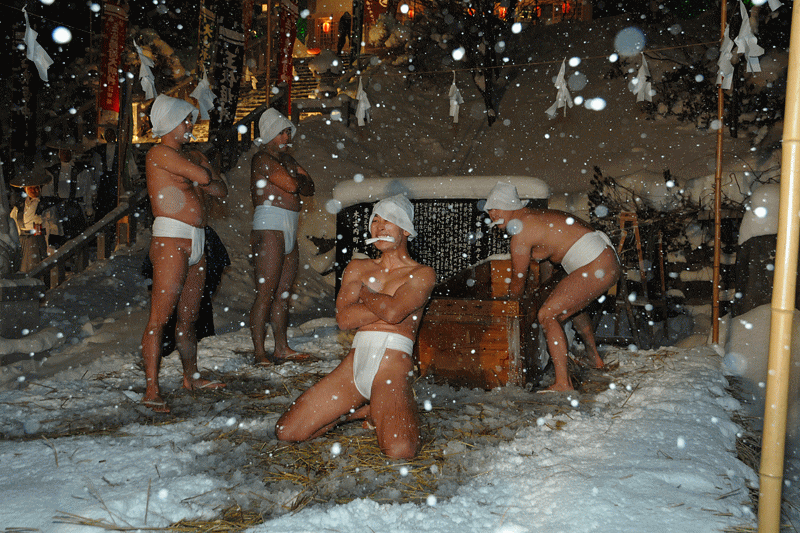
|
|
拡大写真(2400x1600)709KB |
|
|
|
|
|
|
|
寒中みそぎ |
|
|
KANCHU
MISOGHI THE MIDWINTER ABLUTION
|
|
|
▲▼ 4人の行修者は、心身ともに壮健で穢れのない男子から毎年1名ずつが選ばれ、北の大地で厳寒の一月に4年連続3日間昼夜の別なく命をかけて行うみそぎは大変な苦行であるが、これまでの長い歴史の中で1人の離脱者も出ていないという。 厳寒の北海道においては神社におけるこのような「みそぎ」行事は佐女川神社のみで見られる。
行修者は、四年間で四つの役を担い、それぞれ担当するご神体を清めてく。初年度は弁財天(七福神の中でただ一人女性の神。一般的に弁天様といわれる。学芸と技能の神、財福の神)を、二年目は山の神(大山津見神(おおやまづみのかみ):大山に住むといわれ、山を司とる神。樹木を司とる神、開運美人の守り神)を、三年目は稲荷(宇迦御魂神(うがのみたまのかみ)お稲荷様として知られている。商工業・農業の神)を務め、お清めするご神体も役目と同じ名前のものである。 |
|
|
Four young men who perform Misogi are called Gyoushusha the Ascetics. One respectable young man who is vigorous in body and mind is selected to be Gyoushusha every year. Once a young man is selected Gyoushusha, he has to serve continuously
for four years. Gyoushusha plays four roles in the four years. It is one of the hardest ascetic practices. But it is said that there were none who abandoned their mission in the middle in the past long history. In the bitter cold of Hokkaido, such "purification ceremony" has been holding only at Samegawa Shrine.
|
|
|
|
|
|
|
|
雪中禊ぎをする行修者・稲荷
/ アニメーション 1月13日18:58
|
|
Purifying Gyosyusya (ascetics)
Inari in snow / animation January 13 18:58
|
|
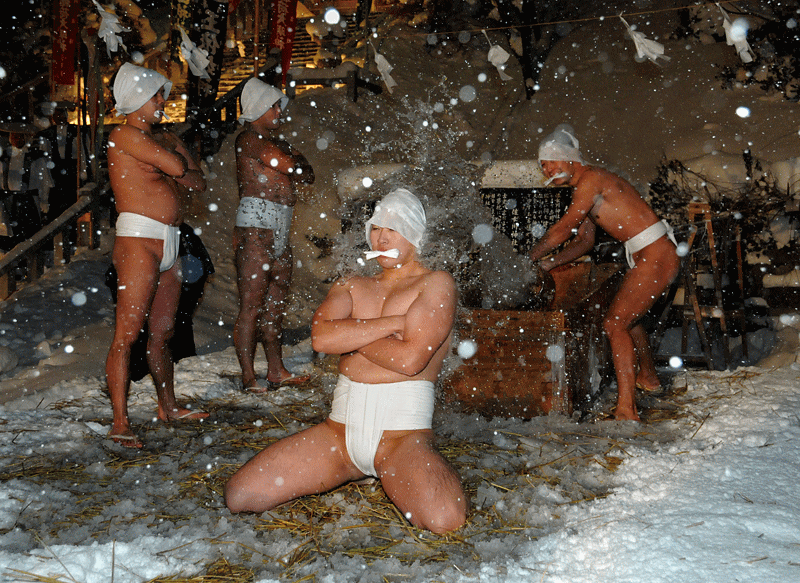
|
|
拡大写真(2400X1750)871KB |
|
|
|
|
|
|
|
▲▼
行修者は、四年間で四つの役を担い、それぞれ担当するご神体を清めてく。初年度は弁財天(七福神の中でただ一人女性の神。一般的に弁天様といわれる。学芸と技能の神、財福の神)を、二年目は山の神(大山津見神(おおやまづみのかみ):大山に住むといわれ、山を司とる神。樹木を司とる神、開運美人の守り神)を、三年目は稲荷(宇迦御魂神(うがのみたまのかみ)お稲荷様として知られている。商工業・農業の神)を務め、お清めするご神体も役目と同じ名前のものである。 |
|
|
The first year Gyoushusha serves as Benzaiten (female shinto deity of wealth, arts and sciences), the second year as
Ooyamazumi-no-Kami (shinto deity of mountain, trees and good luck), and the third year as
Inari (shinto deity of industry, commerce and agriculture).They purify sacred bodies of the deities whose name they have
carry that year.
|
|
|
|
|
|
|
|
|
|
ご神体 2016年1月15日
|
|
Four sacred bodies of the deities on Jan 15, 2016
|
|
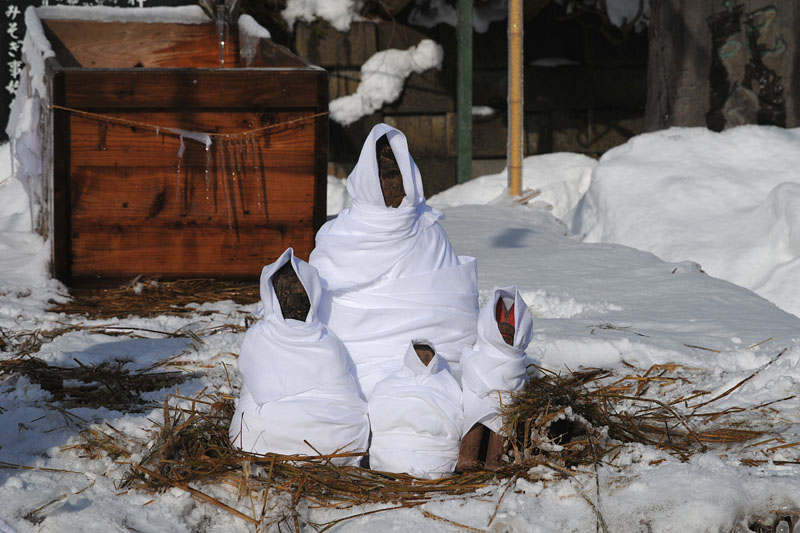
|
|
拡大写真(2400X1600)517KB |
|
|
|
|
|
|
|
最終の四年目は別当を務め、お清めするご神体は佐女川神社の主祭神である玉依姫命(ご利益は、海上安全・交通安全・縁結び・安産)である。別当とは「みそぎ事はじめ」に出てくる神社守のことであり、日頃神社を維持管理しご祭神をお守りしている、祭神に身近な存在の者をいう。 |
|
|
In the final year Gyoushusha plays as Betto and purifies
Tamayorihime-no-Mikoto. This
Mikoto is main enshrined deity at Samegawa Shrine. Betto is the man who maintains Samegawa Shrine and also guards
The Mikoto. He is the person who is the most familiar to
the Mikoto. |
|
|
|
|
|
|
|
|
|
|
Gyosyusya (ascetics) with their sacred of the deity at Misogi Beach in January
15
|
|
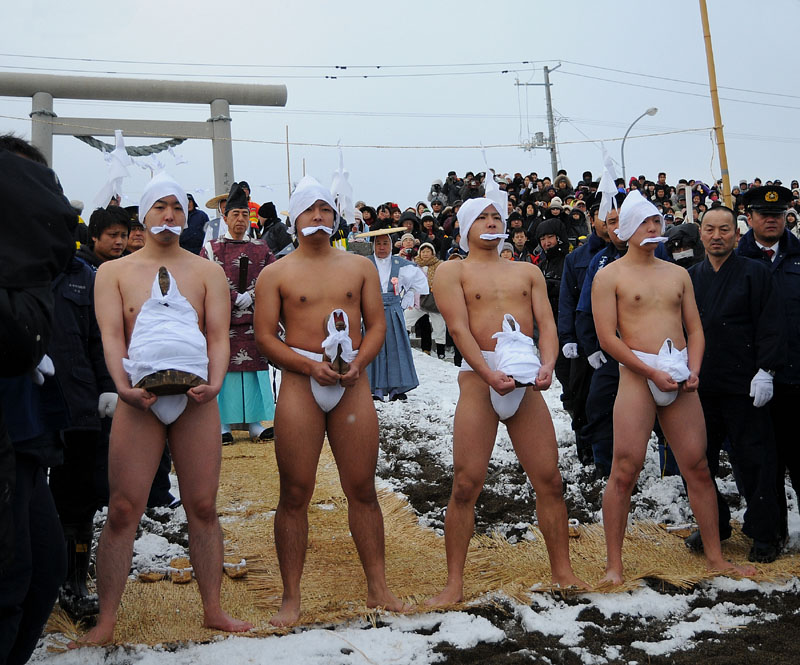
|
|
拡大写真(2200X1830)570KB |
|
|
|
|
|
|
かんごりや よにんぎょうじゃの こんのしろ |
|
Winter Ablution, white of the loincloths of four ascetics. |
|
|
|
|
津軽海峡に入水して御神体を前に合掌する |
行修者 |
たち |
|
|
Gyosyusya (ascetics) join their hands in prayer in the
Tsugaru Strait
|
|
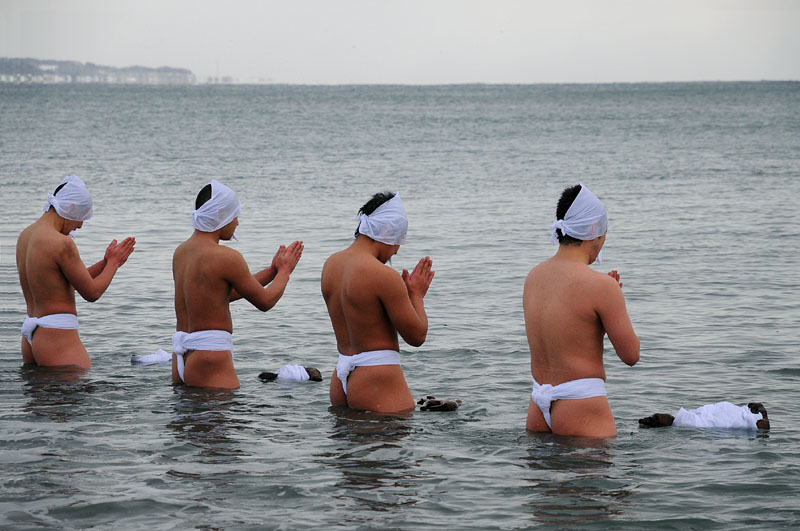
|
|
拡大写真(2200X1460)386KB |
|
|
|
|
|
|
|
みそぎ事始め |
|
|
THE
BEGINNING OF THE ABLUTION
|
|
|
天保2年(1831)正月17日早朝、佐女川神社の神社守は、夢の中で「ご神体を清めよ」とのお告げがあって目を覚まし、寒風肌を突き刺す中、すぐに神社真下の川へ向かい、小川の氷を打ち砕き、身を切るような冷たい川の水を桶に汲んで何回もかぶってみそぎを行った。
それから神社に戻り、ご神体を抱いて海岸に行くと、大きな鮫がいて、その背中には白衣をまとった美しい女性の姿あった。女性を神の聖なる使者だと信じた神社守は、御神体とともに何度も極寒の海で沐浴した。しかし神社守が気づいた時には既に女性の姿はなく、河口にいた大きなサメも上流へと上り、小さな沼へ消えていった。神社守が御神体とともに海へ入り、自身の体と御神体を清めたその年からは、不思議なことに村の豊作豊漁が続いて賑わいを見せた。この言い伝えから「寒中みそぎ」の行事が行われるようになったという。 |
|
According to a legend, a man who guarded Samegawa Shrine had a dream in the early morning of January 17, 1831. He was told in the dream to purify the sacred body of the deity. He woke up and went to a river near the shrine right away. After crushing ice in the river, he took cold water from there and purified himself many times.
He came back to the shrine and then went to the beach with the sacred body of the deity. He saw a beautiful woman in white that was standing on a shark in the sea. He believed that she was the messenger of Kami the deity. Then he purified multiple the sacred body of the deity and himself in the sea. At one moment he noticed that she disappeared and the shark went
to the upstream of the river. Curious to say, the village experienced a good harvest and
big fish catch and was prosperous since this strange event. After this, people in Kikonai began to do Kanchu Misogi the Midwinter Ablution.
|
|
|
|
|
|
|
|
|
|
|
Gyoushusha are heading to purify on Jan
13
|
|
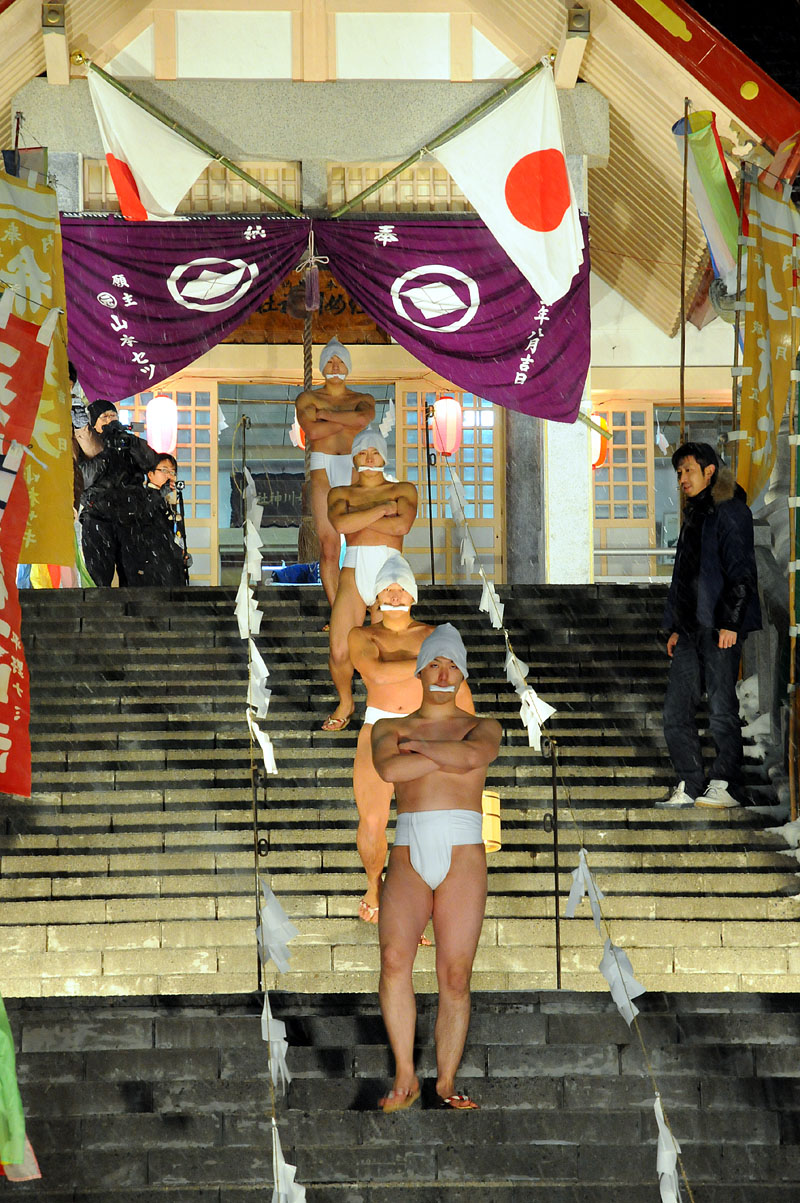
|
|
拡大写真(1063X1600)297KB |
|
|
|
|
|
|
|
祭りの日程 |
|
|
SCHEDULE
OF THE FESTIVAL
|
|
|
一昔前までは「寒中みそぎ」は1月13日から17日まで5日間かけて行われる長丁場だったが、今では13日から3日間、次の日程で行われている。
1月13日 午後6時〜 参籠(さんろう)報告祭に引き続き「みそぎ」修行
14日 「みそぎ」修行
15日 午前10時〜 出御祭(みそぎ浜に向け出発)
午前11時50分〜 みそぎ浜にて海中みそぎ
午後2時〜 本祭 ご神体を納め神楽を奉納 |
|
The Festival of Midwinter Ablution lasts 3 days in the following schedule.
on January 13 from 06:00 p.m. Ceremony of starting
the Festival of Midwinter
Ablution
on January 14 from 05:30 p.m. Ascetic practices
of Misogi
on January 15 from 10:00 a.m. Ceremony of departing to Misogi Beach
from 11:50 a.m. The start of Misogi in the sea.
from 02:00 p.m. Ceremony of reporting the finish of Misogi to Kami
from 02:30 p.m. Dedication
of Matsumae Kagura (sacred music and dancing)
|
|
|
|
|
|
|
|
|
松前神楽 1月15日 15:28
|
|
|
|
Shinto
Music 'Matsumae Kagura' on Jan 15 15:28
|
|
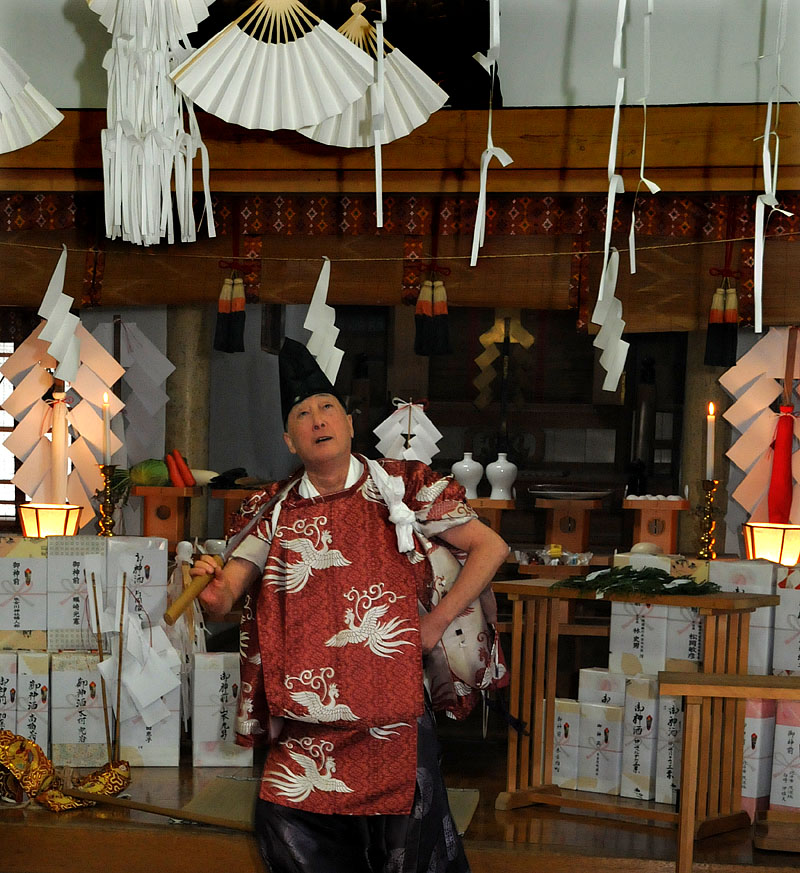
|
|
拡大写真(1650X1800)453KB |
|
|
|
|
|
|
|
神
楽 |
|
|
KAGURA
THE SHINTO MUSICAL
|
|
|
▲▼ 神楽は、日本の民俗芸能のなかでも古い起源を持つ。本来は、神座に神を迎えて清めや祓いなどを行う神事の祭に演じられる芸能で、「神楽」と呼ばれるようになった。神楽は、現在、日本全国で様々なものが伝承されており、松前神楽は日本最北部で行われている神楽である。 |
|
|
Kagura originates from Japanese folk tradition. There was originally the ritual ceremony to purify in order to pray for long life after inviting Kami (a Japanese Shinto deity). The Ceremonial art that took place in the ritual ceremony began to be called Kagura. Various Kagura are spread now all over Japan. Matsumae Kagura is the Kagura that is performed in the northernmost area of Japan.
|
|
|
|
|
|
|
|
|
|
|
ししのまう まつまえかぐら かみのうた |
|
A lion dance of Matsumae kagura, the song of deities. |
|
|
|
|
|
|
Lion
Dance of Matsumae Kagura on Jan 15 15:27
|
|
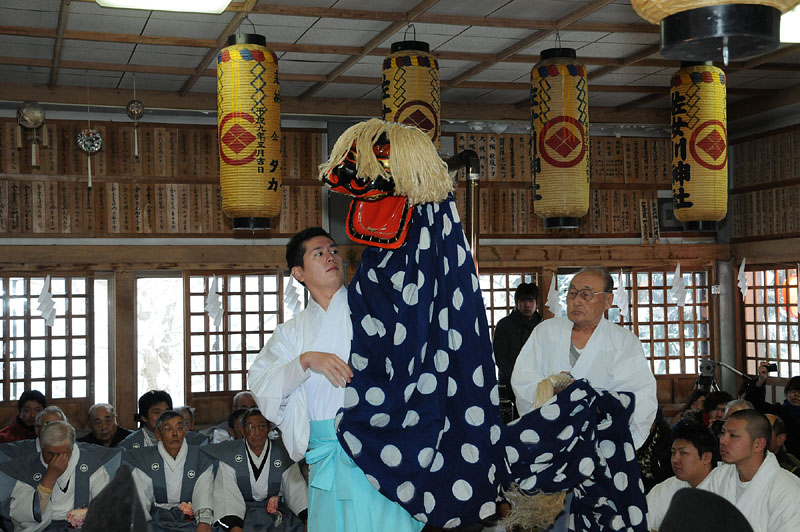
|
|
拡大写真(2000X1330)430KB |
|
|
|
|
|